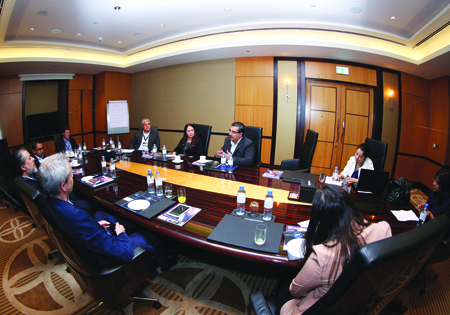With OTT discussed throughout boardrooms this year, Brightcove and BroadcastPro ME got together with leading industry figures to debate the business of OTT, and the opportunities and challenges involved for all the stakeholders The Middle East and North African TV market is not the same as the US or the UK markets. Viewing habits are […]

With OTT discussed throughout boardrooms this year, Brightcove and BroadcastPro ME got together with leading industry figures to debate the business of OTT, and the opportunities and challenges involved for all the stakeholders
The Middle East and North African TV market is not the same as the US or the UK markets. Viewing habits are hugely different, in part based on culture. Then again, it is difficult to categorise the MENA region as one vast pan-Arab market. With huge expatriate pockets dotting the landscape and so much variety within Arab culture, one size does not fit all.
The complexities of catering to a diverse range of people has become easier with OTT offerings, giving people a global platform to pick and choose what they want although all of it is not entirely legal. No longer are viewers bound by packages offered by linear TV. With smart phone penetration among the world’s highest in countries like Saudi Arabia and the UAE, suddenly content has become more easily available through the internet. Regulators are still playing catch up excuse the pun.
Regional broadcasters have been quick to provide OTT offerings and some have been shouting themselves hoarse that viewers in the region are not permitted to watch content on Netflix and other platforms that do not have a licence to operate in the region. This brought us back to the table to discuss issues and possible solutions.
How can we stop people watching content that is not legal to view in this region? Can linear TV survive in its current format or will we see a cosmic shift? Most broadcasters are investing in OTT while advertisers are placing significant chunks of their ad budgets in digital platforms, but is there any ROI yet?
Leading the debate was Luke Gaydon, Vice President of Strategic Initiatives, Media at Brightcove who began with the question that is on everyones lips these days what are the chances of survival for linear TV?
In the course of his introduction, he pointed out that in the UK, the future of linear broadcasting seems to lie in live content.
Debating the topic were Samer Abdin, CEO of Istikana; Sanjay Raina, CEO of Fox International Channels Middle East; Dominic Farrell, Director Platform & Digital Technology, Broadcast Operations at OSN; Manoj Mathew, Chief Content and Creative Officer, MEA and Pakistan, Zee TV; Samer Geissah, VP – Consumer Home and Multimedia, Du; and Nabeeha Mohaimdi Bradford, Digital Editorial And Special Projects Senior Manager, Digital Media Department TV & Radio, Dubai Media Inc.
Will linear TV survive?
Most of the attendees agreed with Gaydon that linear TV in its current format may not last much longer. Manoj Mathew of Zee pointed out that linear TV as we see it today will slowly be phased out.
Nabeeha Bradford agreed, saying that as someone who oversees the OTT editorial and several digital projects at DMI, the future for a linear broadcaster lay in readjusting to the view that it shouldnt be broadcasting whenever it wanted but when the viewer wanted it.
I do watch linear TV but my child already only watches whatever she wants, whenever she wants to, on her device. With the new generation having different options to watch content, I cant see linear broadcasting continuing in its current format. It must change to suit the requirements of the viewer.
Sanjay Raina, CEO of Fox vehemently opposed any suggestion of a linear TV death warrant.
TV viewing in the MENA is very different from the UK or the US so those examples dont work here. You have to see how mature audiences in China, Japan and other parts of Asia watch TV and those trends are very different from the US or the UK. TV is a community affair in most Asian countries and having more than one TV is not necessarily the norm in every home. Its true that kids between the ages of four and fourteen prefer tablets and smart devices to the big TV but at 15, they will return to the screen at home because it is community driven and TV becomes a talking point.
Linear TV is not going to die. There is enough space for linear TV for the next hundred years. People want to watch TV in large parts of the world as singular units or families. It may die in certain age groups for a certain period of time but it will come back. If anyone of us is here in a hundred years, it will still be linear TV that provides most of the revenue.
Dominic Farrell who recently joined OSN from BSkyB, where he played a crucial role with their OTT offerings, added that increasingly, customers want to watch time-shifted TV.
People are extremely busy and their free time is precious, so they want to be able to access content when and where they want it and OTT lends itself very nicely to time-shifted TV. I think the shift towards on-demand viewing will be very dependent on the size of the catch up offering that any service provides. I did a lot of extensive research around content discovery particularly in the home and the order in which people search for content when looking for something to watch. They typically first look for content on linear TV, then they sift through anything they have recorded and the on-demand catalogue is usually the last option. Unless you have a considerable catch up catalogue that takes that fear away from viewers that they are missing something thats on right now, theres always going to be a trend towards linear viewing. Once you have got that depth of catch up content, there will be more of a shift from linear to time-shifted viewing, as viewers will be confident that even if they miss something on linear, they will be able to view it at a later date via the catch up service.
Dus Samer Geissah redefined Linear TV as live content being broadcast by the broadcaster on any device explaining: We are seeing a decline in the traditional way of watching episodes. People are not tied to the grid anymore. But it will disappear eventually because people will say they want to watch drama episodes when they want.
Samer Abdin of Istikana, which has a huge catalogue of Arabic content agreed that anything live will continue to find favour on linear.
However, he also explained that sometimes a viewer likes recommendations and the cues that guide him to view a programme rather than being bombarded with a vast and complete choice without any guidance.
We have worked hard on trying to understand what modes are available for people to discover content. At the moment, linear offers some signals to the viewer such as the time when the programme is broadcast and the ratings. The problem with OTT is there is so much out there but not necessarily enough cues to guide people on which programme may appeal to them. There is, therefore, this tension in the mind of the viewer between having a complete choice and being told what to watch. As OTT gets better with these social cues and sending signals to the viewer and the better we are at discovery, the more OTT will replace some aspects of linear viewing, and linear TV will lean towards live events.
Brightcoves Gaydon took this opportunity to discuss the editorially curated voice versus content discovery. Seeing that there are exciting algorithms at play here and a lot of surface recommendations that could potentially affect ratings, he queried what options were in place at the moment to push OTT content with viewers.
One feeds the other, Abdin commented. The hashtags on Twitter and the buzz on social media leads people to watch content online. There is a correlation between first airings, social media activity and how its watched on OTT. There is space for linear TV and it helps OTT because the first airing creates that buzz. At the moment, they are not mutually exclusive. They are complementary.
In this context, Raina of Fox added that there was a need for smarter set top boxes and integration with apps to enable remote operations. Geissah commented that they were already working towards this integration with the new du View app.
OSNs Farrell pointed out that meerkating (the act of TV viewers engaging with a second screen at the same time as watching broadcast television) was increasingly common in all markets.
The challenges of OTT
The discussion then gradually moved to the many pitfalls of operating in the OTT space at the moment. OTT seems to be focused on catch-up, giving content owners little incentive to produce fresh content.
Istikana, for instance, only distributes content and does not produce any. Abdin says producing content as opposed to distributing it is a very different game.
The money is different, the risks are different and the skills it requires are different.
Zees Mathew pointed out that once the platform fees and the middle men (in this case, MCNs) were paid off, there was very little left for the broadcaster/content provider to justify producing exclusive content for an OTT platform. However, he also added that the ability to more accurately profile viewers meant advertising could be better targeted.
We have yet to develop good advertising models for OTT and perhaps thats why no one has made any money on it except perhaps YouTube, one of the participants chuckled.
Mathew stated that the cost of creating appointment viewing is very high and OTT presently purely serves to help people catch up.
You are first creating the content and then creating a liability with the appointment. OTT gives you the option now to watch what you have missed but you cant live on catch up forever. Fresh content will drive more traffic. Netflix is successful because there is catch up and new content, he stated.
The panelists were also quick to add that a lot of people confuse OTT with YouTube or assume that YouTube is the road to success for those operating in the OTT space.
YouTube has yet to prove itself as a monestisation platform for premium content. That’s why you do not see a lot of premium progamming there. What YouTube does extremely well is help new talent in a strong way, both in terms of achieving recognition as well as initial financial success. These creators could well become the new wave of premium producers of Arabic content in the region, added Abdin.
In search of the magic OTT business model
Gaydon gradually steered the conversation to OTT business models from renting and selling content to offering different subscription packages. He asked the panellists to explain some of their own business models for their OTT offerings.
Geissah stated that du started off by offering OTT as a complementary service to its existing TV subscribers. The telco is now looking at offering special packages to its mobile subscribers and also exploring other avenues to generate revenue first within the UAE and then, outside.
It will charge a premium to those who are not its IPTV or mobile subscribers. Another revenue model that du is exploring is free content with personalised advertising.
Free content will carry advertising and vendors will be given a better understanding of who sees what and when. The indication we have is that advertisers are willing to pay to have a more accurate profiling of their audience, which, in turn, helps them to tailor their ads.
Farrell from OSN commented that different business models lend themselves to different types of content. Research is crucial to understanding viewership habits, how people like to watch their content and how they like to pay for it.
The more research you do, the more you can tailor your offerings, he advised.
Nabeeha chipped in with how DMI altered its strategy based on how its content was being consumed.
We were showing Harim Sultan online and were charging a small fee of AED 2 for people to watch it but no one seemed to want to pay. So we decided to make it free of charge and we had 10,000 plus users watching it every day. When the last two episodes were being aired, we decided to charge AED 5 for each and suddenly, it worked. The revenue generated covered our entire target. Of course, it worked because the content was not available anywhere else.
In short, by feeding the addiction and charging a nominal fee at the end, the state broadcaster was able to recover its costs.
Sanjay Raina commented at this point that content owners and platforms who create a viable business model for distribution of content on six-inch screen devices will see revenue.
The six-inch device is the future, he said, adding that National Geographic was also going to launch its own player to encourage viewing.
Advertising in the OTT space
Foxs Raina commented that many companies are now investing a substantial sum of their ad budgets into digital platforms.
I know of companies that have shifted 40%-45% of their advertising to digital since 2009. Nothing has worked but they call this a ‘hit and trial’ phase. Their point is that they did 50 years of linear and something worked. So in the OTT space, they feel they have to take the same chance and see what works.
He added that companies were now making five-second ads for OTT.
Abdin expressed scepticism about the current form of advertising in the OTT space saying that no one had found the magic button yet.
Targeted advertising sounds good but no one has really cracked it. Facebook advertising is quite interesting because their profiling seems more successful and we have had more successful ROIs from ad spend on Facebook but thats about it.
Sanjay Raina threw some light on how research works and how sophisticated research systems help companies create ads tailored for different segments, including billboard measuring systems, none of which are available in the region at present.
Subscription rates What is reasonable?
Luke Gaydon raised the issue of pricing, asking if the all-you-can-eat subscription model was sustainable, especially if licensing costs for specific content are higher.
Samer Abdin commented that Istikana charges a flat fee of approximately $8 a month rather than complicating it with several layers.
We chose a simple subscription model because layering different offers on top of each other is complicated. Every layer you add to your existing setup requires a new and different set of messages, making it difficult for the viewer to understand exactly what the offer is. Messaging so that you avoid the situation where they thought they had a right to access all your content because they paid a subscription fee for it, only to find that more money is required, is not so easy. For that reason, a transactional VOD within a subscription model did not work for us, Abdin stated.
Nabeeha queried whether an OTT platform can persuade customers to watch content that is available everywhere.
We offer the breadth of our library. If you are willing to scout other pirate sites, you can. A lot of Arabic content is pirated but we try to compete on a convenience factor and completeness factor and we ask for a subscription in return. For the content that is available elsewhere, we can guarantee ad-free, seamless cross-platform viewing in the best quality. Pirate sites cannot do that, not even close. So we try to push those messages and thus far we have had great feedback from the market, explained Abdin, adding that payment gateways in the MENA was a painful point of discussion as many subscribers do not use credit cards or a payment system that works online.
Raina justified it saying the region does not have a robust e-commerce system that supports the use of credit cards and it wasnt the consumers fault.
Piracy
This part of the discussion drew a lot of debate. Luke began the discussion by giving the example of a Nordic industry commentator, who took the view that piracy is purely the fault of content creators, because as long as they insist on distributing the content and allowing it to be consumed at different times, it will be misused. He asked the participants if they agreed that eradicating windowing would eliminate piracy.
Foxs Sanjay disagreed. Having worked with Sony Pictures in his younger days, he said that he is a firm believer in windowing but he believes in crunching the windows.
A nine-month gap between a film being screened in the theatre and then, being screened on other windows is not going to work. Whether it is two weeks or nine months, the windowing is critical but it must go after that to SVOD or if you have a robust transactional model, it can go straight from the theatre to that.
Geissah revealed that BitTorrent traffic is growing in the UAE.
Our own monitoring shows us that BitTorrent consumes upto 80% of our traffic after midnight.
While every panelist vehemently opposed piracy, some pointed out that if compelling content was offered at an affordable price point, piracy could be contained substantially.
The solution is a combination. There must be regulations to mandate the content, and block and manage it as required. But simultaneously, there is the responsibility of ensuring that viable alternatives are available to the viewer. Otherwise, were asking for trouble. Merely blocking a service is not helpful, Geissah reiterated.
Samer Abdin seconded that saying that if the studios work better with online providers to offer a compelling online offering, the consumer may stop downloading content because it is an inconvenience.
In many instances, they agreed that the people who download content also perhaps have a paid subscription but choose to download content because it is not available when they wanted it, bringing the discussion back to the significance of content anytime, anywhere.
They also agreed that white listing content suppliers was not entirely possible, with legislation varying from country to country in the region.
One suggestion from Abdin was to cut pirate channels off at the funding level.
Perhaps it will help to work with the advertising networks to cut off the funding and urging them not to work with such web sites, but then again, content rights is always a contentious issue. Owing to the lack of transparency in the market, what is offered at a huge premium to a big client could potentially be offered at a cheaper price to smaller channels.
Raina added that at least a million boxes are floating in the market from operators who dont have a licence to broadcast in this region.
Hard and soft piracy, and the fact that even most youngsters know how to circumvent the system if a VPN is blocked, is not helping the cause.
The only thing that is going to work is offering compelling content at a palatable price, everyone agreed.
When season four of The Walking Dead was broadcast in the US, day 2 saw 1.25 million downloads of the episode on the second day in the MENA region. Although there was a suggestion that Hollywood studios should step in to counter piracy, panelists said the market was too small for the studios to justify having a solid presence in the region. Additionally, most studios operate through agents in the region. Unless a body such as the MPA comes to this market, we won’t see much change, they added.
Conclusion
The group concluded by stating that linear TV needs to revise its existing format to survive. New business strategies should take into account the new mobile device and have more content for the six-inch screen. Zees Mathew said gamification would take OTT forward. Raina said that TV is beautiful and fascinating while everything else was a cookie. However, he added that the future of broadcast lies in mobile devices owing to its portability and the convenience of taking it across regions. Abdin commented that its still an open field, and linear and OTT at the moment are not mutually exclusive but complement each other. Geissah said OTT is the future, and Farrell agreed.
There will be a shift in customer expectations. Services previously perceived to be add-ons or value-add services will quickly become almost like hygiene factors to people who are distributing content. Viewers are going to expect their content to be available any time across multiple devices. This will be the fundamental shift we can expect, Farrell said.
Gaydon concluded the discussion by stating that he himself is an example of exhibiting relatively new consumer behaviour.
I have a Netflix subscription in the UK and the device that I use it on the most is my iPhone. I watch it 45 minutes on the bus on the way to work and 45 minutes on the way back home. Thats a relatively new behaviour and I have been doing that for the last four or five months. A year ago, I would never have thought that would be the case. I believe most consumers are exhibiting similar behaviour. So the challenge to the people around this table is to meet and exceed consumer expectations for availability of high quality content anytime, anywhere and on any device.
















































































